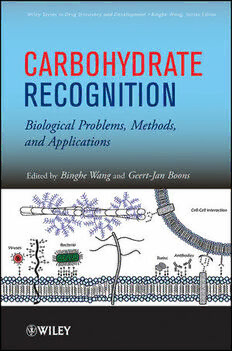Table Of ContentCARBOHYDRATE
RECOGNITION
WileySeriesinDrugDiscoveryandDevelopment
BingheWang,SeriesEditor
DrugDelivery:PrinciplesandApplications
EditedbyBingheWang,TerunaSiahaan,andRichardA.Soltero
ComputerApplicationsinPharmaceuticalResearchandDevelopment
EditedbySeanEkins
GlycogenSynthaseKinase-3(GSK-3)andItsInhibitors:DrugDiscoveryandDevelopment
EditedbyAnaMartinez,AnaCastro,andMiguelMedina
AminoglycosideAntibiotics:FromChemicalBiologytoDrugDiscovery
EditedbyDevP.Arya
DrugTransporters:MolecularCharacterizationandRoleinDrugDisposition
EditedbyGuofengYouandMarilynE.Morris
Drug-DrugInteractionsinPharmaceuticalDevelopment
EditedbyAlbertP.Li
DopamineTransporters:Chemistry,Biology,andPharmacology
EditedbyMarkL.TrudellandSariIzenwasser
Carbohydrate-BasedVaccinesandImmunotherapies
EditedbyZhongwuGuoandGeert-JanBoons
ABCTransportersandMultidrugResistance
EditedbyAhce`neBoumendjel,JeanBoutonnat,andJacquesRobert
DrugDesignofZinc-EnzymeInhibitors:Functional,Structural,andDiseaseApplications
EditedbyClaudiuT.SupuranandJean-YvesWinum
KinaseInhibitorDrugs
EditedbyRongshiLiandJeffreyA.Stafford
EvaluationofDrugCandidatesforPreclinicalDevelopment:Pharmacokinetics,
Metabolism,Pharmaceutics,andToxicology
EditedbyChaoHan,CharlesB.Davis,andBingheWang
HIV-1Integrase:MechanismandInhibitorDesign
EditedbyNouriNeamati
CarbohydrateRecognition:BiologicalProblems,Methods,andApplications
EditedbyBingheWangandGeert-JanBoons
CARBOHYDRATE
RECOGNITION
Biological Problems,
Methods, and
Applications
Edited by
Binghe Wang
Georgia State University
Geert-Jan Boons
Universityof Georgia
Copyright#2011byJohnWiley&Sons,Inc.Allrightsreserved
PublishedbyJohnWiley&Sons,Inc.,Hoboken,NewJersey
PublishedsimultaneouslyinCanada
Nopartofthispublicationmaybereproduced,storedinaretrievalsystem,ortransmittedinanyformorby
anymeans,electronic,mechanical,photocopying,recording,scanning,orotherwise,exceptaspermitted
underSection107or108ofthe1976UnitedStatesCopyrightAct,withouteitherthepriorwrittenpermissionof
thePublisher,orauthorizationthroughpaymentoftheappropriateper-copyfeetotheCopyrightClearance
Center,Inc.,222RosewoodDrive,Danvers,MA01923,(978)750-8400,fax(978)750-4470,orontheweb
atwww.copyright.com.RequeststothePublisherforpermissionshouldbeaddressedtothePermissions
Department,JohnWiley&Sons,Inc.,111RiverStreet,Hoboken,NJ07030,(201)748-6011,fax(201)
748-6008,oronlineathttp://www.wiley.com/go/permission.
LimitofLiability/DisclaimerofWarranty:Whilethepublisherandauthorhaveusedtheirbesteffortsin
preparingthisbook,theymakenorepresentationsorwarrantieswithrespecttotheaccuracyorcompletenessof
thecontentsofthisbookandspecificallydisclaimanyimpliedwarrantiesofmerchantabilityorfitnessfora
particularpurpose.Nowarrantymaybecreatedorextendedbysalesrepresentativesorwrittensalesmaterials.
Theadviceandstrategiescontainedhereinmaynotbesuitableforyoursituation.Youshouldconsultwitha
professionalwhereappropriate.Neitherthepublishernorauthorshallbeliableforanylossofprofitoranyother
commercialdamages,includingbutnotlimitedtospecial,incidental,consequential,orotherdamages.
Forgeneralinformationonourotherproductsandservicesorfortechnicalsupport,pleasecontactour
CustomerCareDepartmentwithintheUnitedStatesat(800)762-2974,outsidetheUnitedSlatesat
(317)572-3993orfax(317)572-4002.
Wileyalsopublishesitsbooksinavarietyofelectronicformats.Somecontentthatappearsinprintmay
notbeavailableinelectronicformats.FormoreinformationaboutWileyproducts,visitourwebsiteat
www.wiley.com.
LibraryofCongressCataloging-in-PublicationDataisavailable.
ISBN978-0-470-59207-6
PrintedintheUnitedStatesofAmerica
oBookISBN:9781118017586
ePDFISBN:9781118017562
ePubISBN:9781118017579
10 9 8 7 6 5 4 3 2 1
CONTENTS
PREFACE vii
CONTRIBUTORS ix
1
MAMMALIAN GLYCAN BIOSYNTHESIS: BUILDING ATEMPLATE
FOR BIOLOGICAL RECOGNITION 1
M.AdamMeledeo,VenkataD.P.Paruchuri,JianDu,ZhiyunWang,
andKevinJ.Yarema
2
THEROLES OF CARBOHYDRATE BINDING INCELLADHESION
AND INFLAMMATION 33
KenKitajimaandChihiroSato
3
THEROLE OF CARBOHYDRATES INVIRAL INFECTIONS 65
GillianM.Air
4
THEROLE OF CARBOHYDRATES INBACTERIALINFECTIONS 93
RolandJ.Pieters
5
THEROLES OF CARBOHYDRATE BINDING INFERTILIZATION 107
DavidJ.Miller
6
CARBOHYDRATE BIOMARKERS 133
YunfengCheng,NantingNi,HanjingPeng,ShanJin,andBingheWang
7
GALECTINS AND THEIR ROLEINVARIOUS BIOLOGICAL
PROCESSES 157
SarikaSaraswati,AshleyStanleyBlock,andAlanB.Diekman
8
GLYCOIMMUNOLOGY 181
AniGrigorian,BarbaraNewton,andMichaelDemetriou
v
vi CONTENTS
9
TOOLSFOR GLYCOMICS: GLYCAN AND LECTIN MICROARRAYS 205
ChristopherCampbellandJeffGildersleeve
10
COMBINATORIAL BIOSYNTHESIS OF COMPLEX
CARBOHYDRATES 229
HaiYuandXiChen
11
MASS SPECTROMETRY IN CARBOHYDRATE SEQUENCING AND
BINDING ANALYSIS 257
GregoryO.StaplesandJosephZaia
12
SYNTHETIC LECTIN MIMICS ARTIFICIALCARBOHYDRATE
RECEPTORS 301
XiaochuanYang,Yunfeng(Jerry)Cheng,andBingheWang
13
LECTIN BINDING AND ITSSTRUCTURAL BASIS 329
AnnabelleVarrot,BertrandBlanchard,andAnneImberty
14
MULTIVALENCY IN CARBOHYDRATE BINDING 349
MarkL.WolfendenandMaryJ.Cloninger
15
CARBOHYDRATE BINDING AGENTS: POTENTIALTHERAPEUTICS
WITH MULTIPLE INHIBITORYACTIONS AGAINST ENVELOPED
VIRUSES 371
K.O.Franc¸oisandJ.Balzarini
16
INFORMATICS FOR GLYCOBIOLOGYAND GLYCOMICS 409
KiyokoF.Aoki-Kinoshita
INDEX 427
PREFACE
There is a growing awareness that the number of genes encoded in the genomes of
multicellular organisms is insufficient to accommodate the diversity of cellular inter-
actionsandproteinfunctionsrequiredfordevelopmentandviability.Therefore,protein
post-translationalmodification,inparticularglycosylation,musthavemuchmoreimpor-
tant roles than previously appreciated. It is now well established that almost all cell
surface and secreted proteins are modified by covalently-linked carbohydrate moieties
and the glycan structures of these glycoproteins are essential mediators in processes
such as protein folding, cell signaling, fertilization, embryogenesis, neuronal develop-
ment,hormoneactivity,andtheproliferationofcellsandtheirorganizationintospecific
tissues.Inaddition,overwhelmingdatasupporttherelevanceofglycosylationindiseases
suchaspathogenrecognition,inflammation,innateimmuneresponses,thedevelopment
of autoimmune diseases, and cancer. Thus, it is obvious that studying recognition
processes involving carbohydrates at the molecular level is critical to provide a proper
understandingofamultitudeofphysiologicalandpathologicalprocesses.
This book highlights a number of important biological recognition processes in
which complex carbohydrates play a critical role. Furthermore, several diseases are
described in which cell surface carbohydrate are prominently involved and the final
part of the book describes experimental techniques used to study carbohydrate recog-
nitionprocesses.Thefirstchapterprovidesanoverviewofthebiosynthesisofcomplex
carbohydratesandthemetabolicprocessesthatleadtocarbohydratestructuraldiversity.
Chapter 2 deals with the involvement of complex carbohydrates in cell adhesion and
inflammation. Many viral and bacterial infections involve recognition of host carbo-
hydratesbymicrobialcellsurfaceproteinsandChapters3and4highlightthesemolecu-
larprocesses.Chapter 5describes indetail theinvolvement of glycosylated proteinsof
the egg zonae and the sperm surface in fertilization. Tumor progression is associated
withtheappearanceofunusualcarbohydratesonthesurfaceofcells,andtheexpression
of these tumor associated carbohydrate antigens provide opportunities for the devel-
opment of diagnostics and immuno-therapies and this important field of research is
coveredinChapter6.Chapter7dealswithgalectins,whichareafamilyof14mammalian
carbohydrate-binding proteins that recognize lactose moieties yet vary considerably in
function. Galectins have been shown to be involved in biological processes such as
celladhesion,cellactivation,growthanddifferentiation,chemoattractionandapoptosis.
Galectinshavealsobeenimplicatedindiseasessuchascancer,inflammationandstroke.
Chapter 8 describes the involvement of carbohydrate-protein recognition event in
immunological processes and topics such as antibody regulation by N-glycosylation
andN-glycaninteractionsinT-celldifferentiationarecovered.Thefinalsevenchapters
dealwithtechnologiesusedforstudyingcarbohydraterecognitionprocesses.Chapter9
covers the use of lectin and glycan arrays to determine recognition specificities and
vii
viii PREFACE
Chapter 10 describes chemo-enzymatic methods for the preparation of well-defined
complexcarbohydrates.Thenextthreechaptersdealwithcarbohydrate–proteinbinding
and the development of artificial carbohydrate receptors, the structural basis for
carbohydrate-protein binding, and the importance of multivalency for high avidity
bindingisdescribedindetail.Chapter14dealswithbioinformaticsapproachtouncover
molecular mechanisms in glycobiologyand the final Chapter 15 provides an extensive
description of carbohydrate sequencing technologies by mass spectrometry using
heparansulfateasaparadigmcomplexcarbohydrate.
Amultidisciplinaryapproachisoftenrequiredforaddressingthecarbohydraterec-
ognition phenomenon. By covering a diverse range of subjects, this book has brought
togetherexpertsfromdifferentfields.Therefore,wehopethatitwillnotonlyhighlight
disease-relevant biological problems involving carbohydrate recognition, but also
promote communications among researchers from different disciplines working on
suchtopics.
Geert-JanBoonsandBingheWang
CONTRIBUTORS
Gillian M. Air Department of Biochemistry and Molecular Biology, University of
OklahomaHealthSciencesCenter,OklahomaCity,Oklahoma,USA
Kiyoko F. Aoki-Kinoshita Bioinformatics Center, Institute for Chemical Research,
KyotoUniversity,Kyoto,Japan
J.Balzarini RegaInstituteforMedicalResearch,K.U.Leuven,Leuven,Belgium
BertrandBlanchard CERMAV-CNRS,Grenoble,France
AshleyStanleyBlock DepartmentofBiochemistry,UniversityofArkansasforMedical
Sciences,LittleRock,Arkansas,USA
XiChen DepartmentofChemistry,UniversityofCalifornia,Davis,California,USA
Yunfeng Cheng Department of Chemistry and Center for Biotechnology and Drug
Design,GeorgiaStateUniversity,Atlanta,Georgia,USA
Mary J. Cloninger Department of Chemistry and Biochemistry, Montana State
University,Bozeman,Montana,USA
Michael Demetriou Department of Neurology and Department of Microbiology and
MolecularGenetics,UniversityofCalifornia,Irvine,California,USA
Alan B. Diekman Department of Biochemistry, University of Arkansas for Medical
Sciences,LittleRock,Arkansas,USA
Jian Du Department of Biomedical Engineering, The Whitaker Biomedical
EngineeringInstitute,TheJohnsHopkinsUniversity,Baltimore,Maryland,USA
K.O.Franc¸ois RegaInstituteforMedicalResearch,K.U.Leuven,Leuven,Belgium
Jeff Gildersleeve Laboratory of Medicinal Chemistry, Center for Cancer Research,
NationalCancerInstitute,Frederick,Maryland,USA
AniGrigorian DepartmentofNeurology,UniversityofCalifornia,Irvine,California
AnneImberty CERMAV-CNRS,Grenoble,France
Shan Jin Department of Chemistry and Center for Biotechnology and Drug Design,
GeorgiaStateUniversity,Atlanta,Georgia,USA
Ken Kitajima Bioscience and Biotechnology Center, Nagoya University, Nagoya,
Japan
M.AdamMeledeo DepartmentofBiomedicalEngineering,TheWhitakerBiomedical
EngineeringInstitute,TheJohnsHopkinsUniversity,Baltimore,Maryland,USA
DavidJ.Miller DepartmentofAnimalSciences,UniversityofIllinois,Urbana,Illinois,
USA
ix
x CONTRIBUTORS
BarbaraNewton DepartmentofNeurology,UniversityofCalifornia,Irvine,California,
USA
NantingNi DepartmentofChemistryandCenterforBiotechnologyandDrugDesign,
GeorgiaStateUniversity,Atlanta,Georgia,USA
Venkata D. P. Paruchuri Department of Biomedical Engineering, The Whitaker
Biomedical Engineering Institute, The Johns Hopkins University, Baltimore,
Maryland,USA
Hanjing Peng Department of Chemistry and Center for Biotechnology and Drug
Design,GeorgiaStateUniversity,Atlanta,Georgia,USA
Roland J. Pieters Department of Medicinal Chemistry, Utrecht Institute for
PharmaceuticalSciences,UtrechtUniversity,Utrecht,TheNetherlands
ChihiroSato BioscienceandBiotechnologyCenter,NagoyaUniversity,Nagoya,Japan
Sarika Saraswati Department of Biochemistry, University of Arkansas for Medical
Sciences,LittleRock,Arkansas,USA
Gregory O. Staples Department of Biochemistry, Boston University Center for
BiomedicalMassSpectrometry,BostonUniversity,Boston,Massachusetts,USA
AnnabelleVarrot CERMAV-CNRS,Grenoble,France
Binghe Wang Department of Chemistry and Center for Biotechnology and Drug
Design,GeorgiaStateUniversity,Atlanta,Georgia,USA
Zhiyun Wang Department of Biomedical Engineering, The Whitaker Biomedical
EngineeringInstitute,TheJohnsHopkinsUniversity,Baltimore,Maryland,USA
Mark L. Wolfenden Department of Chemistry and Biochemistry, Montana State
University,Bozeman,Montana,USA
Xiaochuan Yang Department of Chemistry and Center for Biotechnology and Drug
Design,GeorgiaStateUniversity,Atlanta,Georgia,USA
Kevin J. Yarema Department of Biomedical Engineering, The Whitaker Biomedical
EngineeringInstitute,TheJohnsHopkinsUniversity,Baltimore,Maryland,USA
HaiYu DepartmentofChemistry,UniversityofCalifornia,Davis,California,USA
Joseph Zaia Department of Biochemistry, Boston University Center for Biomedical
MassSpectrometry,BostonUniversity,Boston,Massachusetts,USA

